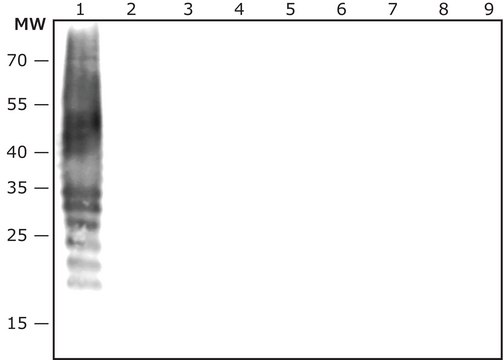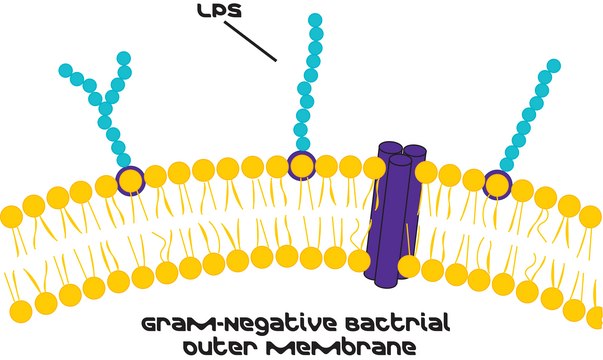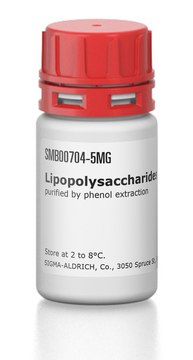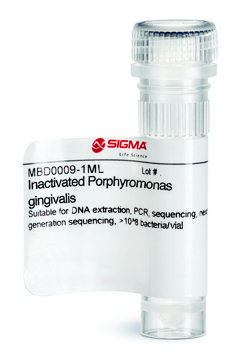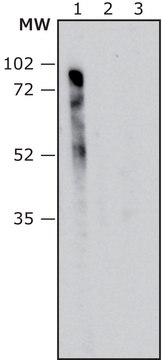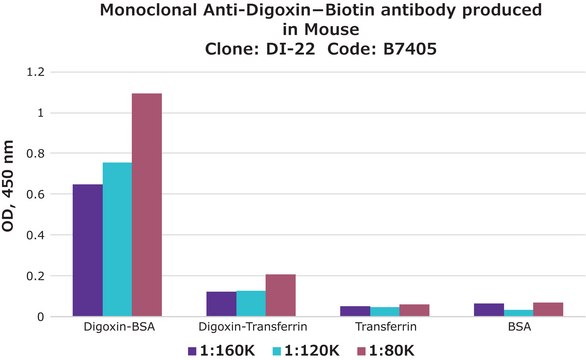General description
Porphyromonas gingivalis is a nonmotile, Gram-negative, rod-shaped, anaerobic pathogenic bacterium, belongs to the Porphyromonadaceae family, phylum Bacteroidetes class.1 P. gingivalis is involved in several pathogenic mechanisms including tissue colonization and destruction, as well as host defense activation.1-5 This bacterium is known for its ability to colonize at the oral cavity and is associated with public health concern. It can also be found in lung, liver, or splenic abscesses and the upper gastrointestinal tract and is related to atherosclerotic plaque disease, Cardiovascular diseases, Adverse pregnancy outcomes, Rheumatoid arthritis (RA), Meningitis or brain abscesses and Alzheimer′s disease.2-8
Specificity
Monoclonal Anti-Porphyromonas gingivalis LPS specifically recognizes P. gingivalis whole extract and P. gingivalis Lipopolysaccharides (LPS), the antibody has no cross reactivity with whole extract of Proteus mirabilis, Proteus vulgaris, E. coli, Pseudomonas aeruginosa, Shigella flexneri, Staphylococcus aureus or Salmonella enterica.
Immunogen
Porphyromonas gingivalis LPS
Application
The antibody is recommended to be used in various immunological techniques, including Immunoblot and ELISA. Detection of the P. gingivalis LPS bands by Immunoblotting is specifically inhibited by the immunogen.
Biochem/physiol Actions
P. gingivalis ability to aggregate in biofilms is considered a significant health risk by elevated resistance to host defense mechanisms and decreased susceptibility to conventional antimicrobials agents.9 P. gingivalis have several potential secreted and membranal virulence factors such as Gingipains proteolytic complex (Rgp and Kgp) which degrade various host proteins, Fimbriae (FimA and Mfa1) responsible for attachment of bacterial cells to host cell surfaces and Haemagglutinins (HagA) involved in adhesion and invasion of host cells.1-10 The host response to P. gingivalis infection may involve immunoglobulin degradation, inactivation of cytokines and their receptors, platelet aggregation, attenuation of neutrophil antibacterial activities and increasing vascular permeability, as well as, prevention of blood clotting.2 Extensive study from recent years, examine the influence of P. gingivalis LPS and P. gingivalis infections on RA disease. The production of citrullinated peptides by P. gingivalis virulence factors arginine gingipains (RgpA and RgpB) followed by peptidyl arginine deiminase enzyme (P.PAD) preferentially citrullinates C-terminal arginine result in host autoimmune response and generation of anti-citrullinated antibodies (ACPAs). Furthermore, in animal models P. gingivalis infection triggered an experimental autoimmune arthritis. 8,11-12
Physical form
Supplied as a solution in 0.01 M phosphate buffered saline pH 7.4, containing 15 mM sodium azide as a preservative.
Storage and Stability
For continuous use, store at 2-8°C for up to one month. For extended storage, freeze in working aliquots. Repeated freezing and thawing is not recommended. If slight turbidity occurs upon prolonged storage, clarify the solution by centrifugation before use. Working dilution samples should be discarded if not used within 12 hours.
Disclaimer
Unless otherwise stated in our catalog our products are intended for research use only and are not to be used for any other purpose, which includes but is not limited to, unauthorized commercial uses, in vitro diagnostic uses, ex vivo or in vivo therapeutic uses or any type of consumption or application to humans or animals.
